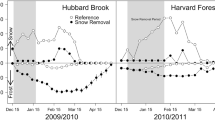Abstract
Conifers decrease the amount of biomass apportioned to leaves relative to sapwood in response to increasing atmospheric evaporative demand. We determined how these climate-driven shifts in allocation affect the aboveground water relations of ponderosa pine growing in contrasting arid (desert) and humid (montane) climates. To support higher transpiration rates, a low leaf:sapwood area ratio (A L/A S) in desert versus montane trees could increase leaf-specific hydraulic conductance (K L). Alternatively, a high sapwood volume:leaf area ratio in the desert environment may increase the contribution of stored water to transpiration. Transpiration and hydraulic conductance were determined by measuring sap flow (J S) and shoot water potential during the summer (June–July) and fall (August–September). The daily contribution of stored water to transpiration was determined using the lag between the beginning of transpiration from the crown at sunrise and J S. In the summer, mean maximum J S was 31.80±5.74 and 24.34±3.05 g m–2 s–1 for desert and montane trees (a 30.6% difference), respectively. In the fall, J S was 25.33±8.52 and 16.36±4.64 g m–2 s–1 in desert and montane trees (a 54.8% difference), respectively. J S was significantly higher in desert relative to montane trees during summer and fall (P<0.05). Predawn and midday shoot water potential and sapwood relative water content did not differ between environments. Desert trees had a 129% higher K L than montane trees in the summer (2.41×10–5 versus 1.05×10–5 kg m–2 s–1 MPa–1, P<0.001) and a 162% higher K L in the fall (1.97×10–5 versus 0.75×10–5 kg m–2 s–1 MPa–1, P<0.001). Canopy conductance decreased with D in all trees at all measurement periods (P<0.05). Maximum g C was 3.91 times higher in desert relative to montane trees averaged over the summer and fall. Water storage capacity accounted for 11 kg (11%) and 10.6 kg (17%) of daily transpiration in the summer and fall, respectively, and did not differ between desert and montane trees. By preventing xylem tensions from reaching levels that cause xylem cavitation, high K L in desert ponderosa pine may facilitate its avoidance. Thus, the primary benefit of low leaf:sapwood allocation in progressively arid environments is to increase K L and not to increase the contribution of stored water to transpiration.
Similar content being viewed by others
Author information
Authors and Affiliations
Additional information
Electronic Publication
Rights and permissions
About this article
Cite this article
Maherali, H., DeLucia, E.H. Influence of climate-driven shifts in biomass allocation on water transport and storage in ponderosa pine. Oecologia 129, 481–491 (2001). https://doi.org/10.1007/s004420100758
Received:
Accepted:
Published:
Issue Date:
DOI: https://doi.org/10.1007/s004420100758




